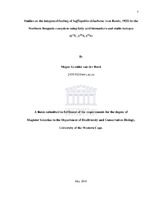| dc.description.sponsorship | The present study employs a multi-tracer approach to shed light on the integrated feeding of the bearded goby Sufflogobius bibarbatus. The study was conducted between 31 March and 10 April 2008 at two 48 hour stations off the Namibian coast, namely inshore(station A, 120 m) and offshore (station B, 180 m). Isotopes of 513C and 515N suggest that the goby diet at station A and B at the time of the study was primarily composed of the jellyfish Chrysaora fulgida and Aequorea forskalea, which comprised up to 73.85 % and 70.36 % of the goby diets respectively. However the importance of these cnidarian prey items, together with adult euphausiids, benthic polychaetes and shrimp varied with goby size, point of collection and habitat. Spatially pooled 534S results suggest that the sulphidic benthic sediment (containing diatoms and sulphur bacteria) overlying the central shelf off Namibia may contribute 34.2 % to the diet of the goby and that the goby
may be able to drive sulphides from the benthos. Fatty acid analyses were limited to data collected only at station B and they suggest that gobies retrieve most of their essential fatty acids from pelagic zooplankton. Furthermore, small gobies at station B were high in the copepod markers 20:1ω9 and 22:1ω11, but their larger counterparts were high in the diatom FA 20:4ω6, 20:5ω3, diatom marker ratios 16:1/16:0 and 20:5ω3/22:6ω3 suggesting that small gobies fed more on pelagic copepods while large gobies fed directly on sedimented diatoms on the benthos. Fatty acid analyses also provided support for sulphur bacterial and jellyfish-feeding amongst gobies. The study highlights the advantages of using multiple trophic tracers to compliment each other, and identifies the bearded goby as an opportunistic feeder that plays an important role in terms of energy transfer within the northern Benguela ecosystem. | en_US |

